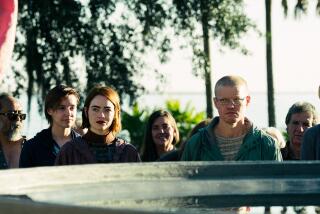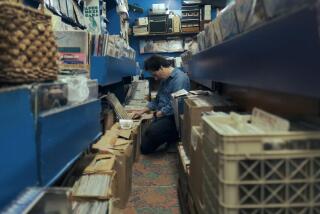Review: All Welles breaks loose in the corrosive, long-awaited ‘The Other Side of the Wind’
- Share via
It probably says something about the present moment that there have been two new movies in two consecutive weeks in which a woman waves a blade perilously close to a man’s nether-regions. Then again, maybe it doesn’t: The two movies, both set in the 1970s and steeped in unease, could otherwise hardly be more dissimilar.
The threat of a little snip-snip in the horror remake “Suspiria,” a story of feminist witchcraft, feels deliberately timed for the cultural reckonings of 2018. By contrast, the late emergence of Orson Welles’ “The Other Side of the Wind” — 48 years after it began production and 33 years after the great filmmaker’s death — could hardly have been planned, and feels all the eerier for it. And while you could easily find a castration metaphor or two amid the glorious, astonishing wreckage of this long-awaited swan song, its sexual politics belong, as they must, to an earlier era.
The woman brandishing the scissors is the Croatian-born actress Oja Kodar, Welles’ co-writer and late-in-life romantic partner. Before she topples a giant phallic sculpture in one especially see-it-to-believe-it scene, she spends a lot of time wandering, tall and dark and uninhibitedly nude, under the desert sun. The camera’s openly admiring gaze tells you that feminism isn’t really on the agenda — and neither, for that matter, is witchcraft, unless the completion of “The Other Side of the Wind” itself is proof of some strange sorcery at work.
Welles shot the picture between 1970 and 1976, then spent his remaining years desperately trying to finish it. But after the director’s death in 1985, the film remained mired for decades in various circles of legal, financial and geopolitical hell — until, finally, a successful rescue mission spearheaded by producers Frank Marshall (who worked on the original film) and Filip Jan Rymsza. The effort was bankrolled by Netflix, which is releasing the film alongside Morgan Neville’s “They’ll Love Me When I’m Dead,” an invaluable decoder ring of a documentary about the movie’s torturous production history.
To dispense with the obvious: It’s odd to see a new motion picture from the director of “Citizen Kane” beamed into your living room via streaming queue. (While most will see the film via Netflix, it is also receiving a brief L.A. theatrical run at Laemmle’s NoHo 7.) Then again, it may also be a fitting outcome — an expression of faith that the titans of cinema might just survive, and in fact depend on, the medium’s future players. That might have pleased Welles, a pioneering Hollywood classicist who conceived of this final opus as a rejoinder to, and an example of, the aesthetically cutting-edge visions of New Hollywood.
And a vision — a cracked, corrosive, savagely compromised vision — it unmistakably is. A mock documentary avant la lettre, “The Other Side of the Wind” has a jagged syntax that would have felt startling in the ’70s and, decades later, has lost little of its restless found-footage vitality. The late cinematographer Gary Graver (who worked on Welles’ “F for Fake”) employs a jittery mix of color and black-and-white, 16-millimeter and 35-millimeter film stocks, and the veteran editor Bob Murawski has cut the results into a rapid-fire approximation of Welles’ late-career style.
The effect of all this rupturous technique — which could hardly seem more removed from the magisterial deep focus of “Citizen Kane,” “The Magnificent Ambersons” and “Touch of Evil” — is to heighten the already chaotic, disorienting mood at the house party where most of the action takes place. It’s the 70th birthday of a cynical, reclusive, Hemingway-esque film director named Jake Hannaford (played by another titan, John Huston), who is deep into production on a picture that has recently stalled.
Hemingway, Hannaford, Huston: If the meta-parallels weren’t clear enough, the cash-strapped film-within-a-film is also titled “The Other Side of the Wind,” though this one appears to be a ludicrous parody of self-indulgent art cinema — specifically Michelangelo Antonioni’s “Zabriskie Point” — as it follows Kodar and a blankly handsome leading man, John Dale (Robert Random), across a vast, rugged and increasingly clothing-optional landscape.
We see long, fascinating stretches of that footage early on alongside Hannaford’s right-hand man, Billy Boyle (actor, director and Welles associate Norman Foster), and a skeptical producer (Geoffrey Land), clearly modeled on then-Paramount Pictures chief Robert Evans. Other sections of the movie are screened, and sidelined by a power outage or two, at Hannaford’s party, where he chomps a cigar and showers unending vitriol on various friends, associates and hangers-on.
Sharp-eyed viewers may spy the young faces of Dennis Hopper, Paul Mazursky and Henry Jaglom moving in and out of the shadows, and also of the Welles scholar Joseph McBride, playing a film historian who assails Hannaford with questions. Sharp-eared listeners will pick up on some acerbic one-liners amid the flow of gossip, some of them from Mercedes McCambridge as a walking bile dispenser and Susan Strasberg as a nosy film critic inspired by Pauline Kael, whose 1971 essay “Raising Kane” had made her a Welles adversary.
But the key supporting player is Hannaford’s closest confidant, an ascendant Hollywood director named Brooks Otterlake (played by Welles’ closest confidant, a then-ascendant Hollywood director named Peter Bogdanovich). Their bond, oiled by knowing banter and clouded by Oedipal and Shakespearean overtones, is the picture’s most fascinatingly complicated. A close runner-up might be Hannaford’s mysterious relationship with the wayward Dale, which leads someone to theorize about the director’s latent desires for his leading men, a fixation that he concealed, revealed and exorcised through the movie screen.
Whatever else it may be — a wrecked, towering monument to its own incompletion, a howl of rage at the industry that Welles helped build and forever define — “The Other Side of the Wind” increasingly comes to resemble a shattered cinematic hall of mirrors. It’s the labyrinth from “The Lady From Shanghai” writ large, its broken surfaces reflecting and signifying the fraught circumstances of its making. What would Welles have made of this posthumous assemblage? Would he have minded its undeniable lapses into tedium? How much of it are we meant to read as thinly veiled auto-critique versus a wickedly funny jape?
Frankly, I’m not sure Welles drew much of a distinction: Every time you sense him veering toward the confessional, you can hear his cackle booming loudly right behind it. But the reverse is true as well. There is one scene in “The Other Side of the Wind” — Hannaford’s version — that must be seen to be believed, in which Kodar mounts Dale in the back seat of a Mustang, having her way with him as rain lashes the outer windows.
It’s an absurd, luridly overheated sequence, yet Welles, never exactly hailed as one of the cinema’s great eroticists, shoots it with such crazy intensity and dynamism and wild bursts of color that it all but transcends its parodic function. It cuts to the heart of this extraordinary, cantankerous wreck of a movie, because it reminds us that even when faced with something he had every reason to despise — whether it was other movies, other people or the industry that spawned and broke him — Orson Welles couldn’t help but turn contempt into art.
------------
‘The Other Side of the Wind’
Rating: R, for sexual content, graphic nudity and some language
Running time: 2 hours, 2 minutes
Playing: Laemmle’s NoHo 7, North Hollywood, and streaming on Netflix
[email protected] | Twitter: @JustinCChang
More to Read
Only good movies
Get the Indie Focus newsletter, Mark Olsen's weekly guide to the world of cinema.
You may occasionally receive promotional content from the Los Angeles Times.











